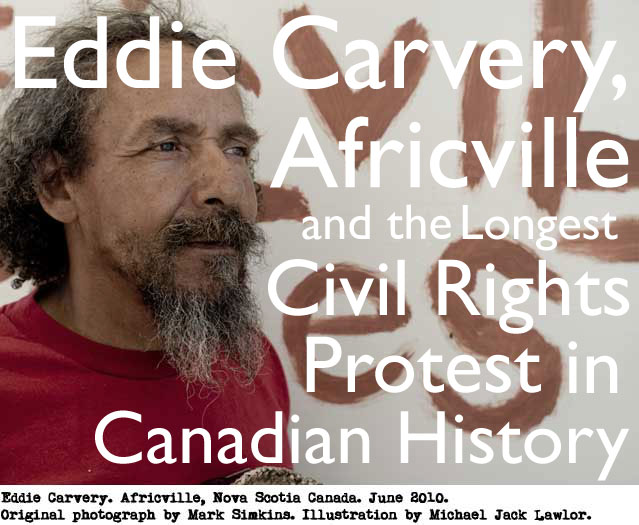
Jon Tattrie, author of “The Hermit of Africville: The Life of Eddie Carvery,” offered to take his cell phone to Eddie Carvery’s protest site in Africville, Nova Scotia so I could interview Eddie from Los Angeles for this story.
After a few minutes on the phone I realized that Eddie is a deeply intelligent, soft spoken man, with a profound sense of social justice.
Eddie’s voice is rarely heard in the corporate or mainstream media. In fact, just a few months before I spoke to Eddie, a Globe and Mail reporter interviewed him about racism in Nova Scotia, but left Eddie’s voice out of the final story.
“They don’t listen to what I got to say because it’s too close to the truth,” said Eddie.
Jon Tattrie is the first journalist to take a serious look at Eddie Carvery and the significance of his 40 year protest against the destruction of his childhood home, Africville.
“I lived in Europe for most of my 20’s and lost touch with Nova Scotia,” said Jon. “When I moved back in 2006 I was startled to see how segregated Halifax is. Black people live out in Preston or in Uniake Square. There is integration in London, England that you don’t see here. Eddie is a hidden protester and I was ready to tell his story.”
I asked Mark Simkins, a photojournalist and filmmaker with deep cultural roots in Nova Scotia, if he would photograph Eddie and Jon for this story. The three men met in Africville one day in June for a photo session. Mark’s photographs appear throughout this story.
![]()
Over a period of 9 years from 1962 to 1970, the City of Halifax, Nova Scotia forced people of African and Jamaican descent out of Africville by systematically knocking their waterfront homes down with bulldozers.
Africville was a 200 year old Canadian community originally populated by Jamaicans who moved to Nova Scotia in the 18th century. The British government deeded Mi’Kmaq land on the shoreline of the Bedford Basin to the Jamaicans, who built roads and fortifications for Halifax.
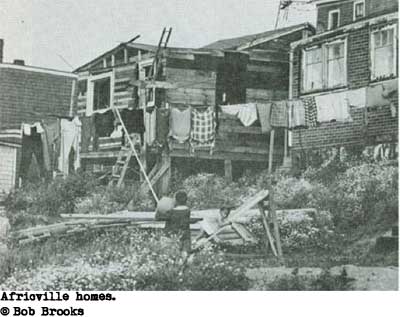
In the 19th century, people of African descent fled slavery in the United States and settled in Africville. The African settlers also contributed to the development of Halifax.
In the 1960’s, using the language of “progress” and “urban renewal” to justify the behaviour, the City of Halifax loaded women and children from Africville into dump trucks and knocked their homes down with bulldozers as they dropped them off with their possessions at condemned houses in other parts of town.
Folks who were not home when the bulldozers arrived lost everything as city workers levelled furnished homes, forcing people into homelessness and destroying generations of keepsakes and heirlooms.
An unidentified victim of the Africville diaspora spoke to a reporter from the Canadian Broadcasting Corporation in 1976 about the destruction of her community.
“They brought us in more or less like you would herd in a bunch of cattle. They used their city dump trucks to load up the children and brought them in and set them in the city. This was a complete disgrace. The City disgraced themselves. They were a perfect disgrace to do that. This is the only place in the world that you would send an old workin’ dump truck to move children, mothers and families into a city. We were in a position, there wasn’t anything too much we could do about it. We were threatened. They put threats on our heads. If you don’t move at a certain time we’ll bring out the bulldozers and push ya’s over, push your shacks over. Now if they call them shacks, we call them our castles. It was our homes,” she said.
The destruction of homes in Africville, and the resulting diaspora, was covered extensively in the mainstream media in the 1960’s. Canadians were told by politicians and journalists that the destruction of Africville was “progressive.” Terms like “urban renewal” and “integration” were used to mask the racism and terror.
“Africville, obviously must be redeveloped. Sometimes, some people need to be shown that certain things are not in their own best interests and not in the best interests of their children,” said John Edward Lloyd, the white mayor of Halifax, on television in the early 1960’s.
In 2002, the United Nations declared the destruction of Africville by the City of Halifax to be a human rights violation.
![]()
Eddie Carvery refused to leave Africville after the City of Halifax destroyed his family home. Since 1970 he has maintained a presence in Africville, signaling his dissent and educating visitors from all over the world about the Africville diaspora.
Mr. Carvery’s protest is the longest civil rights protest in Canadian history.
“The Hermit of Africville: The Life of Eddie Carvery” by Canadian journalist Jon Tattrie, covers Eddie’s life-long commitment to political activism and his early struggle with alcohol, drugs and violence. The book shows how Eddie healed himself through direct political action to become one of the major civil rights activists of his generation.

“When I first started this protest I was angry,” said Eddie by telephone from the Africville protest site. “I was young. Before the protest I had been involved in bouts of alcoholism and dope. I was messed up. Before I started this protest, I believed that I was worthless. I didn’t believe I was a good guy. I was ready to go to jail for the rest of my life. I was poisoned. I was sick. I had become an alcoholic. I was really breaking all the rules. This protest saved my life because it gave me life. It gave me strength. It gave me principles. It gave me morals. I started to look within myself to find out who I was.”
Eddie’s protest has kept Africville visible in the 21st century. He has established himself as an eternal flame on the Halifax shoreline; a post-modern Odysseus whose quest to return home unfolds at home.
“Somebody was responsible for this genocide that was created in Canada and no one is talking,” said Eddie. “This whole society, my society, is gone. The world I knew has disappeared. There is no trace of it. My ancestors helped build this city. I have no choice but to stay here and protest what they did to us and the community and the society. We had our own society. They created a genocide.”
Jon Tattrie modeled his biography of Eddie Carvery on “The Autobiography of Malcom X: As Told to Alex Haley,” a book that documents how Malcolm X overcame racism, violence, drugs and prison to become an agent of social change in the United States.
“The scale of Eddie’s transformation is very unusual,” said Tattrie by telephone. “Eddie didn’t give up violence, or drink and drugs as a principle. He gave them up because fundamentally he understands they do not work and he knows where they lead. His transformation is authentic and quite deep.”
Eddie overcame his addictions and developed a universal sense of justice by examining himself and reading the work of others. Eddie’s personal transformation is an astonishing triumph of the individual over powerful social forces of racism and violence.
As a boy Eddie endured the abuse of a malevolent teacher named Mrs. Beck. The following passage from “The Hermit of Africville” reveals the horror of institutionalized racism.
“This is what you must never be like,” Mrs. Beck told the children, indicating the ramshackle wreckage of a failed pupil. She dramatically held up her hand and counted Eddie’s failings on her fingers. “He’s a liar, he stinks, his hair is never clean, his teeth are rotted and falling out, his skin is greasy and dirty and his clothes are grotesque rags.” The children gasped in horror as they swallowed the old witch’s toxic brew. They could not look away from Eddie and his beastly failure. Eddie didn’t stink, he kept clean and his teeth were fine. But still. “Don’t go near him. He’s contagious. You don’t want his disease,” the teacher concluded, dismissing him for another year.”
Education in Halifax was an extension of a racist political system: a child’s nightmare.
Eddie discovered his native intelligence as a young man doing time in an Ontario prison. The educational opportunities were better in an Ontario jail than they were in a school in Halifax. Eddie started reading and writing in prison. He studied math and drafting and earned a credential to work as a sheet metal worker.
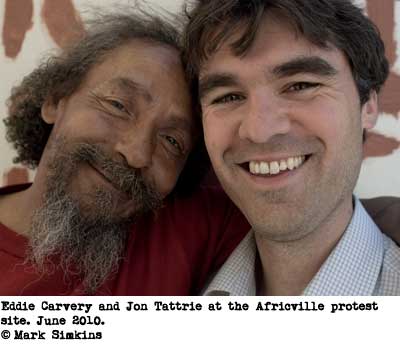
“Prison was like a college for Eddie and for a lot of people of his age and background,” said Tattrie. “They often ran into to racism in school and were unable to get past that. Teachers could be tyrannical and destroy a life. For Eddie, prison was a time to step out of the chaos of ordinary life and build something for the future.”
The capacity for discipline and reason that Eddie developed in prison served him well when he started his civil rights protest and embraced self-study, fasting and abstinence as political tools.
“This protest has changed me,” said Eddie. “I’m not the person I used to be no more, thank God. It took a lot of loneliness and thinkin’ and rethinkin’. Then I started to believe in myself as a person. I don’t think I’m that bad of a person anymore. When I first started this protest, I needed to protest because I was in bad shape. I was confused. I was messed up. I wasn’t ready for the City. I ran back out here to Africville. I used to stay out here and work on my addiction.”
“I took to self educatin’ myself. That’s when I started reading different people. Marcus Garvey and political books from Jamaica. I was putting my thoughts together. Not on paper or nothin’. Just in my head. So I could make some sense of myself.”
“Eventually as time went along things started to straighten themselves out. I found I had a worth. A value. I had somethin’ to say. I started feelin’ confident. I started feeling like a human being. I knew then what I had to do. I would have to continue this struggle.”
“Was not only me falling through the cracks on the floor. Guys my age from my community were falling into the same pattern. We weren’t ready to go to the City to live that lifestyle.”
“With me the protest became a lifesaver. This protest made me the person I am today and I don’t regret that. I regret a lot of things I have done in my life but I don’t regret this protest. I thank God for it, because through this protest I found a purpose in life. I believe what I’m doing is the right thing. I believe that with all my heart.”
![]()
Throughout the 20th century the City of Halifax never extended water or sanitation services to the residents of Africville, even though it collected taxes from property owners there.
The City dumped it’s garbage in Africville, poisoning the community with mounds of toxic waste. City hospitals dumped medical waste in Africville; including needles, bloody rags, blankets infected with TB, and body parts.
The City even ran a sewer pipe from the Victorian-era Infectious Diseases Hospital into the Africville water supply, silently serving the people a toxic cocktail.
“Come to find out the dump they gave us in the 50’s was a toxic waste dump,” said Mr. Carvery. “All of the hospitals, the Camp Hill hospital, the Veterans hospital, all the hospitals used to dump their garbage there. There was no sewage, there was body parts and whatever. We had to endure it.”
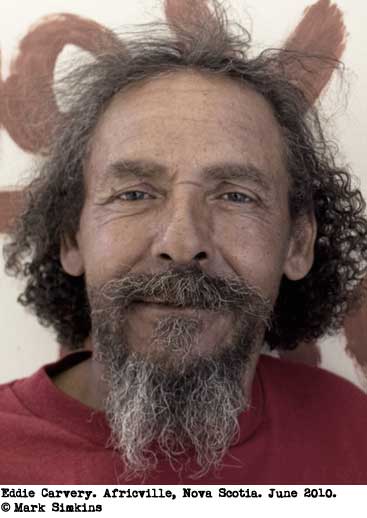
For decades the story of Africville has been presented in media reports from the perspective of the City of Halifax. The City is portrayed as normal and Africville is made to look like an aberration.
“The people of Africville have been portrayed as kids who were left to their own devices and turned their nice neighborhood into a mess, rather than as adults who were consistently oppressed and invaded by the City over a hundred years,” said Tattrie.
“Look at people like Eddie and the old clips of Leon Steed and Joe Skinner and you realize these are intelligent, educated people who knew what was best for their community and understood why conditions had deteriorated.”
In “The Hermit of Africville,” Tattrie tells the story of Africville from the perspective of the people of Africville.
“I made a deliberate point to center the story in Africville,” said Tattrie. “The official history clearly portrays Halifax as the normal place to be and Africville as the outside.”
Tattrie maintains the Africville point of view by drawing on material garnered from his interviews with Eddie Carvery, Victor Carvery and Rocky Jones. Although Tattrie does not romanticize Africville, he does acknowledge the romance of the place.
“The Africville Geneology Society has built up Africville as a romantic bucolic paradise outside Halifax, a place where kids ran free and where everyone was your uncle and aunt. The book tries to explain how both of those things are true. How it was a paradise and how it became the run down place that it was when it was destroyed,” said Tattrie.
Eddie’s struggle with alcohol, drugs, and violence, reflects Africville’s struggle to survive the toxic conditions imposed on the community by the City of Halifax, and the trauma caused by the destruction of family homes.
“Eddie’s story mirrors the story of Africville,” said Mr. Tattrie. “He becomes a toxic waste site himself. The drugs and violence mirror what happened to Africville.”
After decades of polluting the community and denying the residents access to running water, sanitation services, decent education, and economic opportunity, the City of Halifax decided to physically destroy Africville and erase the evidence of systemic racism that was piling up.
The City’s attempt to create a blank slate on the shoreline failed. First, Mr. Carvery’s continuous presence in Africville has served to remind people of the dispersion of his people. Second, in 2004 the United Nations sent Mr. Doudou Diene to Canada to report on race relations. Diene found a “colonial mentality” amoung people of British and French descent who regard themselves as “racially superior” to others.
“After 150 years of collusion between the provincial government and the business community, including through abuse of power, neglect, encroachment and invasion of hazardous industrial materials, in 1970 all of the community was forcefully removed without proper compensation,” wrote Mr. Diene in his report on Africville.
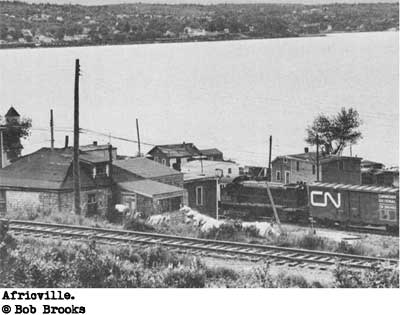
The United Nations report identifies human rights violations and encourages the province of Nova Scotia to re-examine Africville and grant reparations to the victims of the diaspora. The United Nations report echoes Mr. Carvery’s life-long demand for reparations and a public inquiry.
“Canada, especially Nova Scotia, is fond of portraying itself as a scenic place where racism has never been a problem,” said Tattrie. “If you learn about Black history in school in Canada it is usually in connection with the underground railroad and Canada’s role in freeing people who where enslaved in the States. You don’t learn about Africville. The destruction of Africville is still not portrayed as a racist decision when it so clearly was. The long term destruction, from putting the industrial sites there, to putting the dump there, to putting the pollution there, to finally demolishing it was clearly a race based decision.”
Eddie will patiently explain the significance of the Africville diaspora to anyone who expresses an interest.
“We had our school, we had our church, we had our stores, we had our art and they decided that our society wasn’t Canadian enough or somethin’ and that they could treat us less human than they would treat other people. They stole our property and everything and they are still gettin’ away with it. Everybody knows what happened.”
![]()
Stokley Carmichael, the prime minister of the Black Panther Party, visited Halifax in September, 1968. Carmichael was the guest of Rocky Jones, the founder of Nova Scotia’s Black United Front.
At the time of Stokley Carmichael’s visit the process of destroying Africville had been underway for eight years.
The City of Halifax responded to Carmichael’s visit as if it were under attack. Police waited at the airport for Carmichael and Jones to arrive from Montreal and they shadowed the men as they drove into the city from the airport. Snipers took positions on roof tops across from the Arrows Club on Agricola St. as Carmichael and Jones had dinner with their wives.
“The history of Stokley Carmichael’s visit is not recorded,” said Tattrie. “It was a landmark event and it seemed to take the temperature of racism in Halifax at the time. The same people who made the decision to put snipers on the roof, were making the decisions about Africville. Rocky Jones agreed to talk to me about Carmichael’s visit for the book about Eddie.”
Tattrie’s reporting shows how deeply unsettled the City of Halifax became with a Black Panther leader in town at the same time that Black people were being forced out of their homes.
In a fascinating chapter Tattrie reports that Eddie Carvery went to the Arrows Club that autumn evening to hear what Carmichael had to say. Eddie started his Africville protest less than two years after the Black Panther leader left Halifax, rejecting Carmichael’s call to arms in favour of a non-violent protest.
Verdun Mitchell, the police chief responsible for the military-style response to the Black Panther leader’s visit, committed suicide about a week after Carmichael left the city.
![]()
In 1970 Eddie was prompted by his mother to start the Africville protest. His role model was Nelson Mandela.
“I was sittin’ here in Halifax and they had just took our community, our community was gone and we were very hurt about it. Me and my mother were sittin’ up talkin’ about it. My mother was the backbone of this whole protest. When she was in Africville she fought for Africville. She was such a marvelous hard workin’, hard fightin’ woman. She laid it on me because I was going down the wrong road you understand. I was crushed about losing our community and we didn’t know what we could do about it. She suggested to protest.”
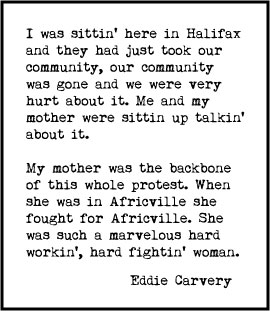
“I thought everybody would catch on right fast because there were a lot activists down in the United States and they were protesting the treatment of Blacks,” said Eddie.
“Nelson Mandela started that protest over there in South Africa. It was around that same time that the Black Panther’s movement got started in the United States.”
“My inspiration was Nelson Mandela. If they could fight racism over there in South Africa, if they could fight racism in the United States, then with what happened to us, why can’t we fight racism right here in Halifax?”
“Apparently it’s OK for them to have the attitude they have toward us and we’re supposed to accept it. It’s not OK with me. It’s never been OK with me. My reason for bein’ here is to fight that.”
“If I hadn’t started this fight forty years ago I don’t think people would even be talkin’ about Africville because it would have been long, long forgotten.”
“It is my purpose now to never let it be forgotten because we do have a heritage and we should be proud. Our forefathers worked very, very hard to build what they left for us. Other people said ‘we are going to take this place from you.’ That’s what they did and it’s wrong.”
“I would just love to see people in our community feel like they are part of this great nation, this country. Feel that they are not being ripped off. Feel like a citizen. Those people degraded us and demoted us so much that I think they are still to embarrassed too talk about it. It’s true what they did and it’s sad. I’m a living remnant of it and so is a lot of people that I see.”
![]()
“One of the things I wanted to reclaim with this book is Eddie’s dawning political consciousness,” said Tattrie. “The political nature of Eddie’s protest is almost never discussed. He is always portrayed as somebody who wants compensation for something that happened forty years ago, but you only have to talk with him for a minute to understand how deeply political he is and how aware he is of the shrinking Black space.”
“Just as most maps of the world shrink Africa, Eddie’s protest is continually shrunk. White people are writing the history and they didn’t take a lot of detailed notes about what the Black people were doing north of the City.”
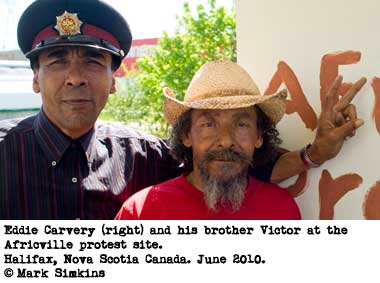
At the heart of Eddie’s protest is a concern for the disappearance of Black communities in Nova Scotia.
“We were the biggest Black space in Canada,” said Eddie. “Africville was a fair size. What was once a part of Black cultural history is gone. We had space granted to us, never to be taken from us, but evidently it has been taken from us. We are not part of this great county anymore because of the fact that we don’t even have a Black space left.”
The scope of Eddie’s demands are usually reduced in the press to make it appear as though he is only interested in money, but Eddie’s demands are clear and concise. The recommendation made by the United Nations to Nova Scotia is in line with what Eddie has been demanding for forty years.
Eddie’s demands are:
- Individual compensation for the victims of the Africville diaspora
- A public inquiry
- A public apology
During a February, 2010 meeting in Halifax the current mayor of Halifax, Peter Kelly, complied with one of Eddie’s demands by offering a public apology.
“The repercussions of what happened in Africville linger to this day. They haunt us in the form of lost opportunities for young people who were never nurtured in the rich traditions, culture and heritage of Africville,” said Kelly.
“Thank you for the apology,“ said Eddie as he checked off one of his demands. “Accepted. One down. Two more to go.”
![]()
Africville did not go away after the City of Halifax destroyed the homes. People keep the spirit alive in music, film and books.
“When I first learned about Africville I was blown away,” said Toronto filmmaker Neil Donaldson in a telephone interview. “During Black History month we learn about Malcom X and Martin Luther King, which is great, but there is a lot to learn about Black history in Africville and Canada.”
George Dixon, the first world boxing champion, was born in Africville. Portia White, the singer, taught at Africville’s school, before the City tore the building down in the 1950’s.
Duke Ellington used to visit his wife’s family in Africville. Ellington performed at the Lobster Trap, a Halifax nightclub, during one of his visits. Louis Armstrong, Joe Louis, and Marcus Garvey also visited the community.
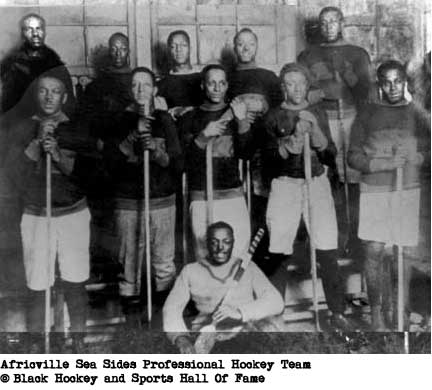
Joe Sealy released a jazz record entitled “Africville Suite.” Black Union recorded a rap song called “Africville” that takes a hard look at the destruction of the community.
Filmmaker Juanita Peterson made a documentary entitled “Remember Africville.” Neil Donaldson made a film called “Stolen from Africville.”
When the City of Halifax destroyed Africville they destroyed the birthplace of ice hockey, Canada’s national sport.
The Africville Sea Sides was a professional hockey team in the Coloured Hockey League from 1895 to 1925. Sea Sides players developed the slap shot and the body check during winter practice sessions at Tibby’s Pond on the Bedford Basin shoreline.
“Black hockey players in the later half of the 19th century, whose style of play and innovations helped shape the sport, effectively changed the game of hockey forever,” wrote George and Darrel Fosty in their book “Black Ice.”
Pa Carvery, Eddie’s uncle whose Africville home in 1970 was the last one destroyed by the City, played defense for the Sea Sides.
The City of Halifax spent $800,000 to destroy Africville.
Eddie Carvery has a vision of a restored Africville, a “funky cultural mecca” on the waterfront that would attract visitors from all over the world.
![]()
“Eddie is consistently portrayed in the media as a homeless guy,” said Tattrie. “Repeatedly called homeless, repeatedly called a squatter. Repeatedly marginalized and portrayed as a guy without ideas who sleeps in the park and is not given credit for what he has done.”
Eddie acknowledges that the media have not treated him or his protest fairly over the years.
“I don’t think the media have been very fair to this side of the protest at all, as a matter of fact,” said Eddie. “Not the City or any newspaper. The Globe up in Toronto went and did this piece and they got everything screwed up because they turned 40 years into 16 years. Statements I made concern’ compensation, they said somethin’ like I was looking for compensation for my grandmother’s property. That’s crap. They know that, yet they put that in the paper.”
In an article entitled “Racism’s long history in quiet East Coast towns” published by the Globe and Mail on May 21, 2010, reporter Les Perraux referred to Eddie as a “squatter” who is “demanding personal compensation” for his grandmother’s property.
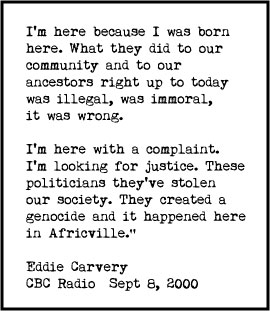
Mr. Perraux does not use the word “protest” in the article, nor does he mention Eddie’s demand for a public inquiry. Mr. Perraux does not explain that Eddie is demanding reparations for all victims of the Africville diaspora, a recommendation also made to the Province of Nova Scotia by the United Nations. In his Globe and Mail report, Mr. Perraux shrank the length of Eddie’s protest from 40 to 16 years.
“He said he’d never stopped protesting since the community was bulldozed,” said Mr. Perraux in an email message. “I have no quibble with that, but the documentation I could find was related to his current camp, so I used that as my starting point for the purposes of the story.”
Rather than corroborate Eddie’s statement that he has been protesting since Africville was destroyed, Mr. Perraux chose to recycle information from Globe archives which shaved 24 years off the protest. He did not include Eddie’s voice in the story.
Jon Tattrie laments the inability of the media to report Eddie’s protest fairly and accurately.
“One doesn’t have to spend much time with Eddie to see that, whatever you think of him as a man or a protester, he is not there for a cash grab, but it is unfortunately nothing new to see the political, racial and spiritual drivers of his protest surgically removed by media reports,” said Tattrie.
![]()
Since 1970 Eddie has maintained a continuous presence on the land the City took from his people.
“At first I was evasive and I used to keep out of sight and that went on for the first five years,” said Eddie. “I became more active and I would put my tents up and the City would tear them down. That was like for a couple of years and I graduated to trailers and then it was more difficult for them to remove me.”
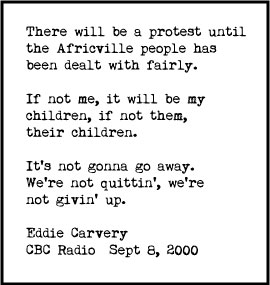
“When I first started the protest it was before the park. They built the park around my protest. My protest was caught in the middle. They decided that they would make a law to make it illegal for me to be in the park overnight. I abandoned that protest and reestablished myself outside the gate. I just stayed. The more determined they were to get rid of me, the more determined I was to stay. I became a fixture. Winter. Summer. Spring and Fall. I was here. I wouldn’t move. I guess I got on a lot of people’s nerves because they did quite a bit of mischievous things to me to break my protest.”
“When they first put the highway in they would drive by at two o’clock in the morning and shoot rifle shots off at me. They had a variety of things they used to do to me to make me uncomfortable and to make me afraid. They used to call me all kinds of wicked, racist names.”
Jon Tattrie sees an uncanny resemblance between Eddie and Old Testament prophets.
“Eddie is quite Old Testament,” said Jon. “Old testament prophets are not recognized in their own land, they are flawed humans, who hurt people and make mistakes. At the same time there is something profound about the core of their existence. I think eventually people will see that in Eddie.”
“You don’t spend forty winters and forty summers sleeping in a field if you don’t have a very profound sense of justice. The funny thing about Eddie is the confidence he has and the optimism of his protest despite all of the frustrations. Eddie is confident and almost serene in the justice of his cause. He is not worried about getting recognition in his lifetime or ever. He knows he is right.”
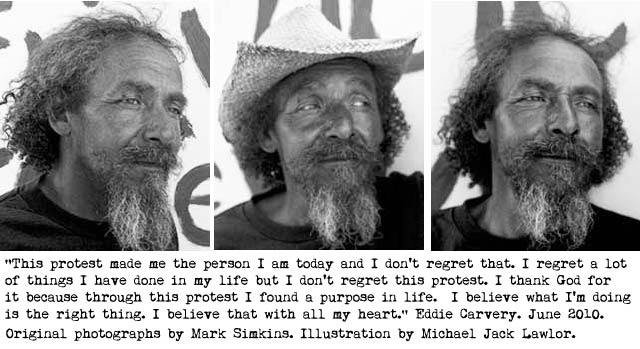


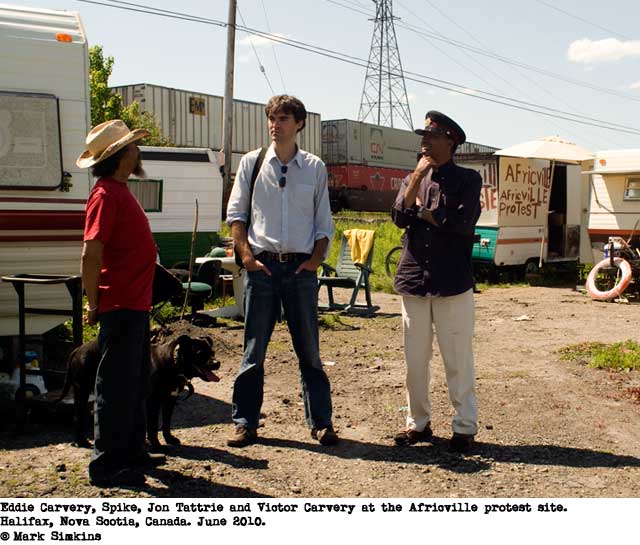
“Eddie Carvery has been protesting the destruction of Africville for 41 years, living in the abandoned fields of his home to fight racism and demand that justice be done. He is doing his job; it’s time for the rest of us to do ours.” – Jon Tattrie
For more information visit Stand With the Hermit! A social media campaign for the Africville Church.
Get a copy of The Hermit of Africville: The Life of Eddie Carvery by Jon Tattrie. You can order by phone at 1-800-646-2879 or from the Nimbus Publishing website.
Visit The Hermit of Africville website and check out Jon’s sources for the book.
Other stories by Jon Tattrie: A Third Carvery Joins Africville Protest Site, The Africville Explosion, Redemption Songs – Bob Marley, Marcus Garvey and Nova Scotia
Listen to The ongoing battle for compensation. This CBC broadcast features an interview with Eddie Carvery.
Watch an interview with Eddie in Africville.
Watch the documentary “Remember Africville.”
Listen to Black Union’s “Africville” rap, featuring Maestro Fresh Wes & Kaleb Simmons.
Read “Halifax Champion: Black Power in Gloves” by Robert Ashe. Mr Ashe reports that police chief Verdun Mitchell committed suicide in the days following Stokely Carmichael’s departure from Halifax.
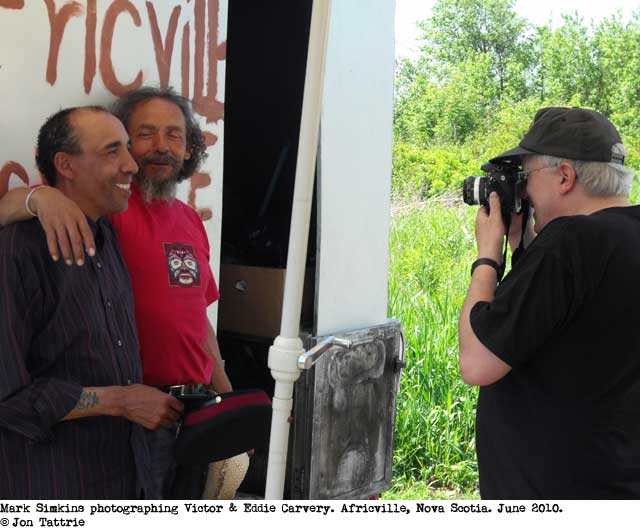
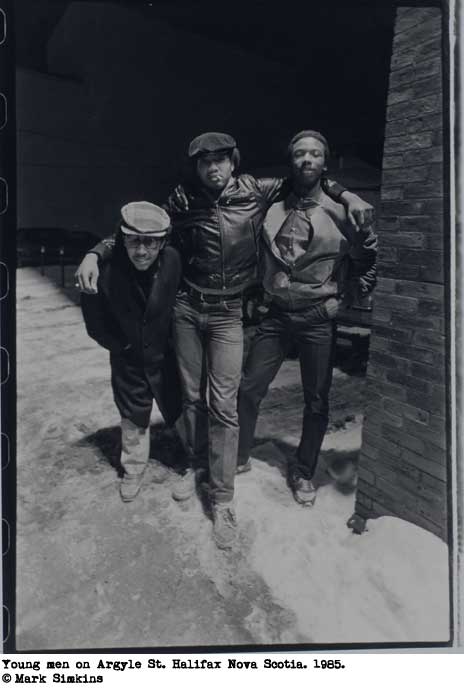

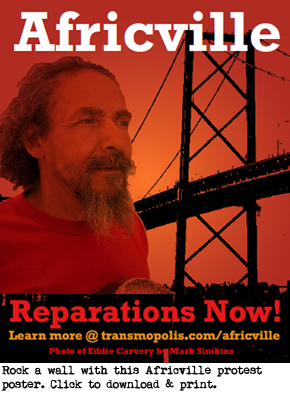



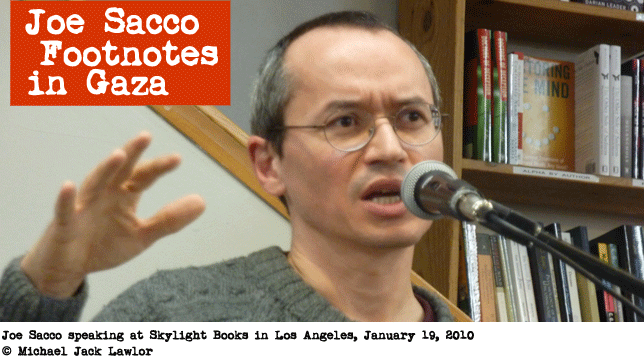
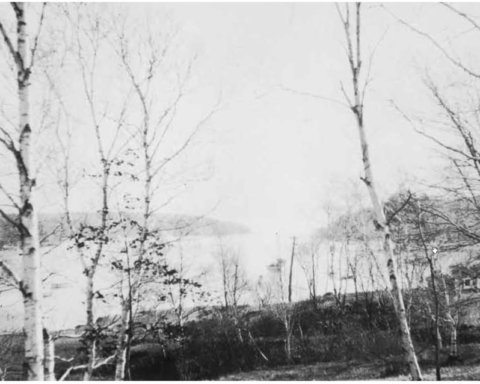

Strong piece, Michael. It really illustrates what Eddie’s protest is about, and how that’s been repeatedly misrepresented.
Thank you Jon.
Michael, I read your article with nonstop interest. The documentary REMEMBER AFRICVILLE was emotionally moving and disturbing. How sad it is that this struggle in Halifax, Nova Scotia did not bleed into the civil rights movement in this country where so many of us believed that our neighbor to the north was a land of compassion and equality for black slaves. How we applauded the decolonialization of African countries and the tearing down of segregation and racial institutions in America, we were so unaware of what was taking place in our backyard. Albeit, many people have been misplaced throughout the ages and it still takes place in many countries throughout the world and will continue until corporate and government greed is replaced by compassion and respect for the rights of all people rather they live in a shoe box, tent or condo. Thanks for such an enlightening article.
Dr Mongo, thank you for reading the article and sharing your thoughts.
Excellent coverage can’t wait to buy the book.
If there is ever a reason to celebrate a man’s work and struggle against all odds
and adversity it would be Mr. Eddie Carvery. I believe the heart and soul of Mr. Carvery is
glowing reflection within each of us.
This page must have brought alot of memories back when you wrote it, it sounds rough for what the
people had to go through in africville, and knowing that some famous people have came from there.
This site is truly “awesome” in the profound original sense of the word. Has taken me an age, I know, to get here Eddy, Victor, Irvine. May not have yet done so had it not been for reading Jon Tattrie’s heart and mind exploding biography “The Hermit of Africville” which spawned interest to seek out more information online. Must admit though, I’d known and loved Eddy Carvery as a brother for decades, worked for his brother Irvine when he was a supervisor at Canada Post in the late 1980s and early ’90s, and met and shared many moments with brother Victor have engaged in his enthusiasm (still do) to inform the public when I was busking in tap shoes entertaining tourists on the Halifax Waterfront in the 1990s and Victor was busily passing out flyers regarding the ongoing struggles of his much maligned people from his birthplace, Africville who were still seeking recognition and compensation while he was speaking to the myriad tourists and general public milling about Halifax harbour who would actually listen and bother to hear him out and respond in kind to his horrific tales of the racism past and present still plaguing this multi-cultural city on Canada’s east coast.
Am honoured to know you Carvery lads, indeed all the surviving folks and descendents of Africville I’ve had the good fortune to meet and love; and remain forever in solidarity with you in the ongoing struggles for recognition and compensation.
Have blogged about Africville in my own way, musically mainly, at one of my blogs sites called “Have you Heard” at the blog.ca domain with the title:
“Got Me Steppin’ For Africville – Let’s Dance Let’s Shout!”
In fact, have “Remember Africville” on dvd on loan from the Northend library which I have every intention of watching again, this time with friends, before this week is through. Am willing all involved with “Peace in all dimensions!”
Since Canada promoted or implemented the ‘Underground Railroad’ movement (or whatever you call it) and since the country promotes or perhaps attempts to promote multiculturalism there are times where I find it hard to believe that Canada could be that racist or that such forms of racism has occurred in a maritime province,having mentioned that,when one gives thoughts of racial tension between blacks & whites it’s the U.S.,South Africa and perhaps Zimbabwe that come to mind but in most cases who would ever assume that Canada can come to mind?
Hi! .. A few years ago I met Eddie & Victor on my soul journey travellings & they & their family were kind to me & sheltered me, for some time, I heard First hand of their adventures & I believe they should be recorded because of their unique experiences .. they were truly amazing, the kind of incredible adventures they had growing up in Africville .. BUT *THERE IS SOMETHING YOU OVERLOOKED WHICH IS ALSO VERY INTERESTING …. EDDIES MOTHER & RELATIVES WERE FROM A TRIBE, A SMALL BAND CALLED THE JEWS!..COULD YOU PLEASE SEND ME ANY INFORMATION?THIS IS WORTHY OF JOURNALISTIC INVESTIGATION I WOULD APPRECIATE YOUR FINDINGS AS SOME OF MY ANCESTORS ALSO COMES FROM THIS TRIBE-SMALL BAND, I FOUND THAT EDDIE & I ARE RELATED! & I WOULD LIKE TO KNOW MORE, ANY PHOTO WOULD BE GREATLY APPRECIATED ..THANKYOU
This article was an eye opener and is a reminder of just how pervasive racism is. My hope is that we all walk away thinking of ways to help those in need. I hope this article isnt just meer entertainment but rather a call to action to help dismantle these oppressive systems that only help the elite. I applaud Eddie but I also wonder who will help him. Who will be the catalyst of change and help him and others who were effected.